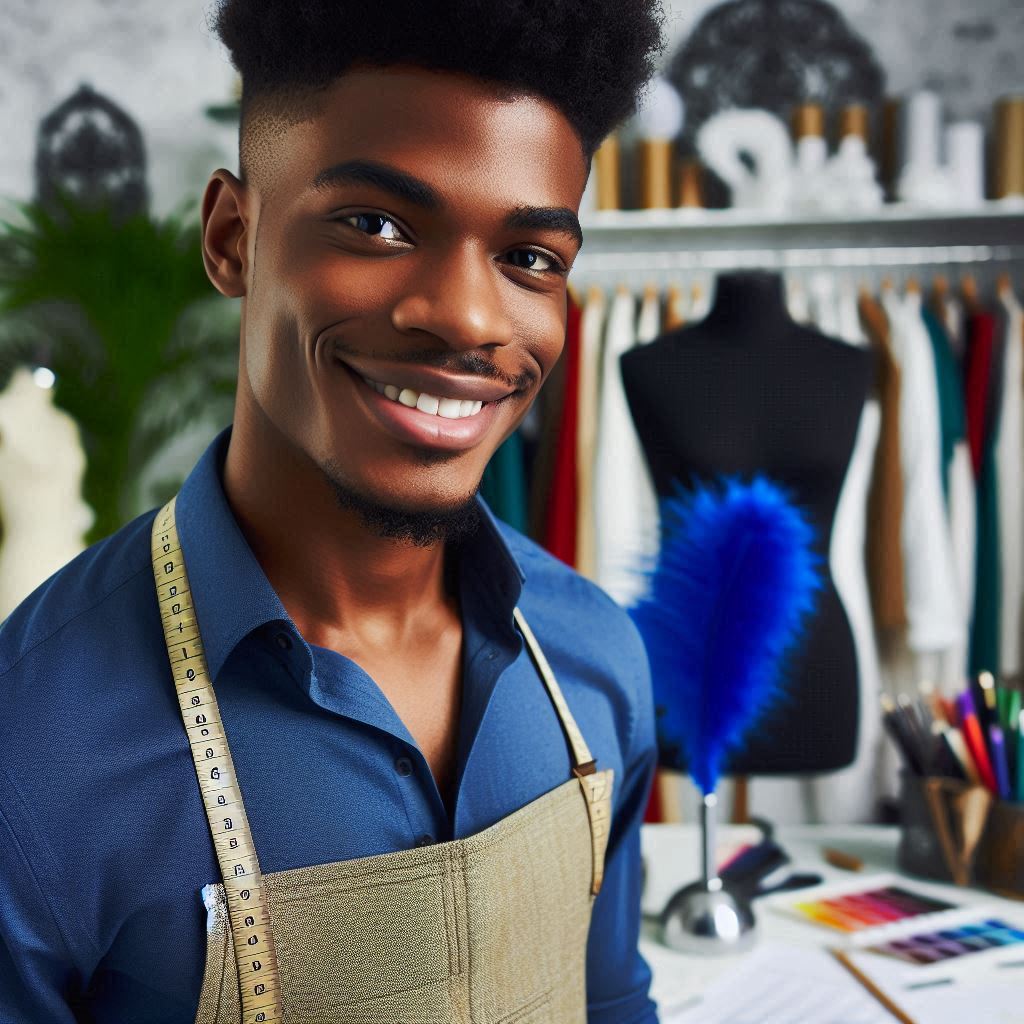Introduction
Costume design is the art of creating clothing and accessories for characters in film, theater, and fashion.
It plays a crucial role in bringing characters to life and setting the tone of a production.
Costume designers are responsible for translating the script and director’s vision into visual garments that reflect the personality and traits of each character.
Staying updated on costume design trends is essential for professionals in the field to remain competitive and innovative.
Trends evolve constantly, influenced by culture, technology, and social movements.
Designers must adapt and incorporate current trends to ensure their work is relevant and resonates with audiences.
As we look ahead to 2024, there are several emerging trends in costume design that are expected to make a significant impact in the industry.
These trends reflect the changing landscape of storytelling and the demand for visually compelling and authentic costumes that enhance the overall production.
From sustainable fashion practices to gender-neutral attire, costume designers are exploring new ways to approach character wardrobe and challenge traditional norms.
By embracing these trends, designers have the opportunity to push boundaries, provoke thought, and create memorable and impactful costumes that resonate with audiences in the modern era.
Let’s delve into some of the key costume design trends that are shaping the industry in 2024 and driving innovation in the creative process.
Technology and Futuristic Designs
How advancements in technology influence costume design trends
Advancements in technology are revolutionizing costume design trends.
Designers now integrate sophisticated tech to push creative boundaries.
The use of 3D printing allows for intricate, customized designs that were once impossible to achieve.
This technology enables the creation of unique textures and structures, making costumes more elaborate and innovative.
The use of 3D printing, LED lights, and smart fabrics in creating futuristic costumes
LED lights are another transformative element.
They enhance costumes by adding dynamic, glowing effects.
These lights can be programmed to change colors and patterns, creating a visually stunning effect on screen.
LED technology makes costumes more interactive and visually captivating.
Smart fabrics are at the forefront of futuristic costume design.
Transform Your Career Today
Unlock a personalized career strategy that drives real results. Get tailored advice and a roadmap designed just for you.
Start NowThese fabrics respond to environmental stimuli, such as temperature and motion.
Designers can create costumes that change color or texture based on the wearer’s movement.
This adaptability adds a new layer of sophistication and functionality to costume design.
Examples of movies or TV shows that showcase cutting-edge costume design techniques
Several movies and TV shows showcase cutting-edge costume design techniques.
For example, “Blade Runner 2049” features costumes with integrated LED lights and innovative materials.
The film’s futuristic aesthetic is enhanced by these advanced design elements.
Another example is “Black Panther,” which uses smart fabrics to depict the advanced technology of Wakanda.
The costumes are both functional and visually striking, demonstrating the impact of technology on design.
“Altered Carbon” also exemplifies futuristic costume design with its use of 3D printing and high-tech materials.
The show‘s costumes highlight the seamless integration of technology in creating immersive, futuristic worlds.
In summary, technology is profoundly influencing costume design trends.
The use of 3D printing, LED lights, and smart fabrics is transforming how costumes are created and experienced.
Movies and TV shows that incorporate these elements illustrate the exciting possibilities of futuristic design.
Read: How to Land Your First Job in Multimedia Design
Sustainability and Eco-Friendly Materials
The shift towards sustainable and eco-friendly practices in costume design
The costume design industry is undergoing a significant transformation toward sustainability and eco-friendly practices.
Designers are increasingly prioritizing environmentally conscious methods, reflecting a broader trend in the fashion world.
This shift is driven by a growing awareness of the environmental impact of traditional costume design processes.
How designers are incorporating recycled materials, organic fabrics, and biodegradable components into their creations
Designers are now incorporating recycled materials into their creations.
These materials, such as repurposed fabrics and recycled plastics, reduce waste and minimize the demand for new resources.
By giving new life to old materials, designers help divert waste from landfills and reduce the overall carbon footprint of their collections.
Transform Your Career Today
Unlock a personalized career strategy that drives real results. Get tailored advice and a roadmap designed just for you.
Start NowThe impact of sustainable costume design on the environment and the industry as a whole
Organic fabrics are also making a strong impact.
These fabrics, produced without harmful chemicals or synthetic pesticides, offer a more eco-friendly alternative to conventional textiles.
Designers are using organic cotton, hemp, and bamboo to create costumes that are both stylish and sustainable.
These materials are not only better for the environment but also for the wearer’s skin.
Biodegradable components are another innovative addition to eco-friendly costume design.
Materials that break down naturally, like certain types of plant-based fibers, help reduce long-term waste.
These components ensure that costumes do not contribute to environmental pollution at the end of their lifecycle.
The impact of these sustainable practices extends beyond the environment.
The industry as a whole benefits from a positive shift towards eco-conscious design.
Consumers are increasingly valuing sustainability, which drives demand for greener options.
As more designers embrace these practices, the entire fashion ecosystem moves towards a more sustainable future.
Overall, the integration of recycled materials, organic fabrics, and biodegradable components reflects a significant step forward in costume design.
This trend highlights the industry’s commitment to reducing its environmental footprint while offering innovative and responsible fashion choices.
Read: Collaborating in Multimedia Art Projects
Cultural Influences and Diversity
How cultural diversity is shaping costume design trends for 2024
In 2024, cultural diversity is profoundly shaping costume design trends.
Designers are drawing inspiration from a wide array of cultural backgrounds, creating vibrant and inclusive fashion statements.
This shift reflects a growing appreciation for global traditions and customs, which are increasingly prominent on runways and screens.
The importance of representation and inclusivity in costume design
Representation and inclusivity in costume design are more crucial than ever.
Fashion plays a pivotal role in shaping perceptions and fostering understanding.
By showcasing diverse cultures, designers promote respect and appreciation for different heritage and experiences.
Transform Your Career Today
Unlock a personalized career strategy that drives real results. Get tailored advice and a roadmap designed just for you.
Start NowInclusive designs allow for a richer, more varied fashion landscape that resonates with a broader audience.
How designers are incorporating elements from various cultures and traditions into their works
Designers are skillfully incorporating elements from various cultures into their collections.
Traditional fabrics, patterns, and techniques are blended with modern aesthetics, creating unique and captivating pieces.
For instance, African kente cloth, Japanese kimono fabrics, and Indian embroidery are being reimagined in contemporary styles.
This fusion not only honors cultural traditions but also innovates within the fashion industry.
The trend towards cultural influences in costume design reflects a larger societal movement towards inclusivity and respect.
As designers continue to explore and celebrate diverse traditions, the fashion world becomes a more vibrant and representative space.
This shift enriches the overall experience of fashion, making it more relatable and inspiring for everyone.
Read: Day in the Life of a Costume Designer

Retro and Vintage Revival
In recent years, we have seen a resurgence of retro and vintage styles in costume design.
Designers are looking back to the past for inspiration, reinterpreting iconic looks from different eras and incorporating them into modern designs.
Influential Eras and Time Periods
Some of the popular eras and time periods that are influencing current design trends include the 1960s, 1970s, and 1980s.
Each era brings its own unique aesthetic, from mod mini dresses and psychedelic prints of the 60s to the disco glam and bold colors of the 70s.
Designers are drawing inspiration from these decades and putting a contemporary spin on them, creating fresh and exciting looks that pay homage to the past while remaining relevant to today’s fashion landscape.
Nostalgia in the Creative Process
Nostalgia plays a crucial role in the creative process for designers who are exploring retro and vintage styles.
It evokes feelings of warmth and familiarity, connecting people to their memories and experiences from the past.
By tapping into these emotions, designers are able to create pieces that resonate with their audience on a deeper level.
Nostalgia can be a powerful tool for designers, allowing them to create garments that not only look good but also evoke a sense of nostalgia and emotional connection.
Basically, the retro and vintage revival in costume design is a testament to the enduring appeal of classic styles and the cyclical nature of fashion trends.
As we move into 2024, we can expect to see more designers drawing inspiration from the past and putting their own modern twist on nostalgic looks.
Transform Your Career Today
Unlock a personalized career strategy that drives real results. Get tailored advice and a roadmap designed just for you.
Start NowRead: Top Costume Design Schools in the USA
See Related Content: Art and Design Career Paths: Job Outlook and Trends
Gender Fluidity and Non-Traditional Fashion
The increasing focus on gender fluidity and non-traditional fashion in costume design
Costume design in 2024 is embracing gender fluidity and non-traditional fashion with bold creativity.
This trend reflects a growing focus on breaking traditional gender boundaries.
Designers are increasingly crafting pieces that blur the lines between masculine and feminine styles, creating versatile and inclusive wardrobes.
How designers are challenging gender norms and stereotypes through their creations
Designers are actively challenging gender norms through their work.
They are experimenting with silhouettes, fabrics, and patterns traditionally associated with one gender.
For example, flowing dresses are paired with tailored blazers, and skirts are designed with utilitarian elements.
This approach defies conventional expectations and encourages self-expression beyond binary gender categories.
The push for non-traditional fashion is not just about aesthetics; it‘s about fostering acceptance and diversity.
By showcasing gender fluidity, designers are making a powerful statement against rigid gender stereotypes.
Their creations advocate for a fashion world where everyone feels represented and valued.
The importance of promoting diversity and acceptance in the fashion industry
Promoting diversity in costume design is crucial for a more inclusive industry.
As designers embrace gender fluidity, they also promote acceptance and understanding.
This shift encourages consumers to challenge their own preconceived notions about fashion and identity.
It opens the door for more varied and authentic expressions of self.
All in all, gender fluidity and non-traditional fashion are reshaping costume design in 2024.
Designers are redefining gender norms and stereotypes through innovative creations.
Their work promotes a more inclusive and accepting fashion industry, reflecting broader societal changes towards diversity and self-expression.
Collaborations and Cross-Industry Influences
How collaborations between costume designers and other industries are shaping trends
Costume design in 2024 is increasingly shaped by collaborations across various industries.
Transform Your Career Today
Unlock a personalized career strategy that drives real results. Get tailored advice and a roadmap designed just for you.
Start NowThese partnerships are pushing boundaries and creating exciting trends.
When costume designers team up with technology companies, they integrate cutting-edge advancements into their work.
Wearable tech and augmented reality are becoming more prevalent, enhancing both functionality and aesthetic appeal.
This fusion of technology and costume design is leading to innovative garments that respond to environmental stimuli or change colors.
How partnerships with technology companies, fashion brands, or artists are impacting costume design
Fashion brands are also influencing costume design.
Collaborations between costume designers and high-fashion houses introduce fresh, runway-inspired elements into costumes.
This partnership brings sophisticated textiles and unique silhouettes to the costume world, elevating the overall design.
High-fashion elements add a layer of luxury and trendiness that resonates well with contemporary audiences.
Artists from different mediums are making their mark on costume design too.
By working with visual artists, costume designers can incorporate artistic elements such as intricate patterns and vibrant colors.
These collaborations foster a fusion of artistic expression and practical design, resulting in costumes that are both visually striking and functionally effective.
The benefits of cross-industry influences on creativity and innovation in costume design
Cross-industry influences enrich costume design by fostering creativity and innovation.
Designers are no longer constrained by traditional materials or techniques.
They are inspired by new perspectives and ideas from their collaborators.
This openness leads to groundbreaking designs that push the boundaries of traditional costume creation.
In summary, collaborations and cross-industry influences are driving the evolution of costume design in 2024.
The integration of technology, fashion, and art is transforming how costumes are conceived and executed.
These partnerships not only enhance creativity but also set new trends in the industry, making costume design more dynamic and forward-thinking than ever before.
Conclusion
Costume design in 2024 showcases bold creativity, sustainability, and the fusion of technology with traditional craftsmanship.
Designers are increasingly using eco-friendly materials to align with the global sustainability movement.
Transform Your Career Today
Unlock a personalized career strategy that drives real results. Get tailored advice and a roadmap designed just for you.
Start NowThe trend toward using digital tools for enhanced creativity is also evident.
Virtual fittings, 3D printing, and augmented reality are becoming common in costume production.
Minimalist designs paired with cultural influences also dominate the landscape.
Staying informed and adaptable is vital in the ever-evolving world of costume design.
New technologies, environmental concerns, and cultural shifts constantly redefine how costumes are created and perceived.
Costume designers must consistently update their knowledge of emerging trends to remain relevant in this competitive industry.
Professionals should embrace new ideas and techniques to create costumes that captivate and inspire.
Incorporating technology, sustainability, and cultural awareness into costume design can result in more memorable and meaningful creations.
Forward-thinking designers who stay adaptable can make a significant impact, ensuring their work resonates with modern audiences.
By embracing these trends, costume designers can lead the way in shaping the future of this dynamic field.
Sustainable practices, innovative technology, and creative design will drive the next generation of costume design forward.
The ability to adapt, learn, and innovate is the key to success in 2024‘s costume design landscape.
In the end, staying current and open to new possibilities is crucial for thriving in costume design today.
[E-Books for Sale]
The Big Book of 500 High-Paying Jobs in America: Unlock Your Earning Potential
$19.99 • 500 High-Paying Jobs • 330 pages
Explore 500 high-paying jobs in America and learn how to boost your career, earn more, and achieve success!
See All 500 High-Paying Jobs of this E-Book
1001 Professions Without a Degree: High-Paying American Jobs You Can Start Now
$19.99 • 1001 Professions Without a Degree • 174 pages
Discover 1001 high-paying jobs without a degree! Unlock career tips, skills, and success strategies for just $19.99!




